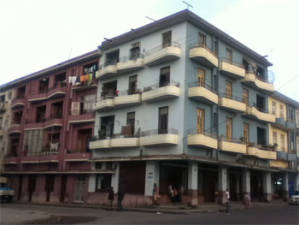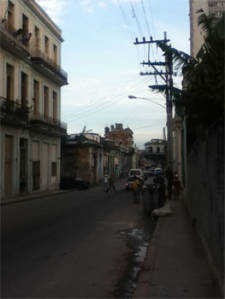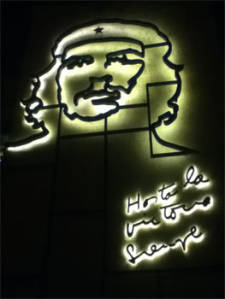The Misery of Poverty in Cuba: Part I of II
Graham Sowa
 HAVANA TIMES — Vedado is the downtown neighborhood of Havana. It is in between the residential Playa/Miramar municipalities and commercial/government oriented Centro Havana.
HAVANA TIMES — Vedado is the downtown neighborhood of Havana. It is in between the residential Playa/Miramar municipalities and commercial/government oriented Centro Havana.
Vedado boasts many popular Havana landmarks such as the Havana Libre hotel and the massive Copelia ice cream parlor. During business hours the latter is surrounded by a phalanx of Cubans waiting in line who are gawked at by tourists leaving from the former.
Not far from these two places, walking distance really (but the tourists still arrive by bus from the hotel), on the corner of 17th and 6th streets, is John Lennon Park.
In the park there is a seated statue of John Lennon on a bench. Some lyrics from his song “Imagine” are inscribed into a marble tile at his feet. The inscription reads “You may say I’m a dreamer, but I’m not the only one”.
 Quite right. And as an artistic affirmation to these words, just a few blocks away there is another Vedado park, with a bas relief of another European writer, artist, and dreamer, Victor Hugo.
Quite right. And as an artistic affirmation to these words, just a few blocks away there is another Vedado park, with a bas relief of another European writer, artist, and dreamer, Victor Hugo.
Victor Hugo was a participant and leader of the 18th century movement to remind humans that there is more to life than the political and scientific ideals of the Age of Enlightenment.
John Lennon imparted a similar message to the Counter-Culture Movement of the mid 20th century. Even though Lennon and Hugo were separated by a couple of hundred years surely The Beatles are a good second act to Hugo’s romanticism.
However, unlike Lennon and the The Beatles, Victor Hugo was a big fan of revolution. He was particularly endeared to the ideals of the French Revolution.
And even though Hugo was born after the death of many of the original First Republic leaders; he still found a grand cause for republicanism and social justice in the doctor cum revolutionary Jean-Paul Marat. Hugo spoke of Marat’s particular form of conditional immortality in this poem:
 “They said Marat is dead. No. Marat is not dead. Put him in the Pantheon or throw him in the sewer; it doesn’t matter—he’s back the next day.
“They said Marat is dead. No. Marat is not dead. Put him in the Pantheon or throw him in the sewer; it doesn’t matter—he’s back the next day.
“He’s reborn in the man who has no job, in the woman who has no bread, in the girl who has to sell her body, in the child who hasn’t learned to read.
“He’s reborn in the unheated tenement, in the wretched mattress without blankets, in the unemployed, in the proletariat, in the brothel, in the jail-house, in your laws that show no pity, in your schools that give no future, and he appears in all that is ignorance and he recreates himself from all that is darkness.
“Oh, beware, human society: you cannot kill Marat until you have killed the misery of poverty.”
In Vedado John Lennon and Victor Hugo are immortalized in bronze. But what about Marat? Is he dead or alive?

Lennon wrote the song in 1968. He may have been a social idealist, but he was not a revolutionary, which is a very different thing. In talking about his song Imagine, John Lennon said,
“‘Imagine’, which says: ‘Imagine that there was no more religion, no more country, no more politics,’ is virtually the Communist manifesto, even though I’m not particularly a Communist and I do not belong to any movement. There is no real Communist state in the world; you must realize that. The Socialism I speak about … [is] not the way some daft Russian might do it, or the Chinese might do it. That might suit them. Us, we should have a nice … British Socialism.”
Like many of us, John Lennon’s outlook evolved during his life, and he became disillusioned with aspects of the revolutionary politics that he had earlier espoused. I’d say though that he never stopped being a social idealist, if perhaps his opinion changed as to how best to achieve those ideals.
All the modern republics and constitutional monarchies you are so fond of would be nothing without the Marat’s throughout History.
Kid you not.
“Revolution” by John Lennon
You say you want a revolution
Well, you know
We all want to change the world
You tell me that it’s evolution
Well, you know
We all want to change the world
But when you talk about destruction
Don’t you know that you can count me out
Don’t you know it’s gonna be all right
all right, all right
You say you got a real solution
Well, you know
We’d all love to see the plan
You ask me for a contribution
Well, you know
We’re doing what we can
But when you want money
for people with minds that hate
All I can tell is brother you have to wait
Don’t you know it’s gonna be all right
all right, all right
Ah
ah, ah, ah, ah, ah…
You say you’ll change the constitution
Well, you know
We all want to change your head
You tell me it’s the institution
Well, you know
You better free you mind instead
But if you go carrying pictures of chairman Mao
You ain’t going to make it with anyone anyhow
Don’t you know it’s gonna be all right
all right, all right
all right, all right, all right
all right, all right, all right
+++
I would say those lyrics are not the thoughts of a revolutionary.
I’m not sure that you are right when you say that John Lennon wasn’t a revolutionary, read the following quote as an example: from http://www.counterpunch.org/2005/12/08/the-lost-john-lennon-interview/
JL: After the revolution you have the problem of keeping things going, of sorting out all the different views. It’s quite natural that revolutionaries should have different solutions, that they should split into different groups and then reform, that’s the dialectic, isn’t it–but at the same time they need to be united against the enemy, to solidify a new order. I don’t know what the answer is; obviously Mao is aware of this problem and keeps the ball moving.
A small quibble: Victor Hugo (1802 – 1885) lived in the 19th century.
A more serious disagreement is over your unqualified praise for Marat. As one of the more extreme voices of the French Revolution, he became a vigorous defender of the radical extreme Left “sans-culottes”. These poor Parisians were inspired by Marat’s constant persecution of “enemies of the people,” and became the foot soldiers of the French Revolution leading to the Terror and the reign of the guillotine. Marat’s radical denunciations of counter-revolutionaries supported much of the violence that occurred during the wartime phases of the French Revolution.
Readers may reflect on who fulfilled this role during the Cuban Revolution, but let’s hope that the “Cuban Marat” is long dead.